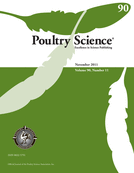Ver ítem
- xmlui.general.dspace_homeCentros Regionales y EEAsCentro Regional Entre RíosEEA Concepción del UruguayArtículos científicosxmlui.ArtifactBrowser.ItemViewer.trail
- Inicio
- Centros Regionales y EEAs
- Centro Regional Entre Ríos
- EEA Concepción del Uruguay
- Artículos científicos
- Ver ítem
A comparative study of culture methods and polymerase chain reaction assay for Salmonella detection in poultry feed
Resumen
The present work compared 2 culture methods and PCR assay for the detection of motile and non-motile Salmonella strains using artificially contaminated poultry feed. The specificity was 1 in all methods. The accuracy and sensitivity were between 0.5 and 1 for motile Salmonella strains, whereas these parameters were between 0 and 0.6 for non-motile Salmonella strains. The positive predictive value was 1 for tetrathionate (TT), PCR, and modified semisolid
[ver mas...]
The present work compared 2 culture methods and PCR assay for the detection of motile and non-motile Salmonella strains using artificially contaminated poultry feed. The specificity was 1 in all methods. The accuracy and sensitivity were between 0.5 and 1 for motile Salmonella strains, whereas these parameters were between 0 and 0.6 for non-motile Salmonella strains. The positive predictive value was 1 for tetrathionate (TT), PCR, and modified semisolid Rappaport-Vassiliadis (MSRV) methods in most of the strains studied. The negative predictive value of each method was very low for non-motile Salmonella strains. The detection level of motile strains was 8 to 20 cfu/25 g for all methods, whereas it was ≥104 cfu/25 g in culture methods for non-motile Salmonella strains. In general, the PCR method detected lower non-motile Salmonella contamination levels in feed than did culture methods. Extending incubation time of the enrichment medium to 6 d in the TT method did not improve the isolation rates. All selective plating media did not show any statistical differences in the parameters of performance studied. Kappa coefficients showed that there was good agreement between TT and MSRV methods, and MSRV and PCR methods for motile Salmonella strains in poultry feed samples. The agreement was fair between TT and PCR methods for these strains. For non-motile Salmonella strains, there was poor (TT and MSRV methods), slight (PCR and TT methods), and fair (MSRV and PCR methods) agreement. The TT, MSRV, and PCR methods are similar in terms of accuracy, sensitivity, specificity, positive predictive value, and negative predictive value for different motile Salmonella strains in poultry feed. For non-motile Salmonella strains, the use of the PCR method improves the same parameters, described before, in this matrix. The difference in detection levels obtained with the methods used for motile and nonmotile Salmonella strains and the difficulty to detect these last strains represent a potential problem, when a poultry feed sample is considered negative for the presence of Salmonella.
[Cerrar]

Fuente
Poultry Science 90 (11) : 2606–2618 (November 2011)
Fecha
2011-11
Editorial
Oxford Academic Press
ISSN
0032-5791
1525-3171
1525-3171
Formato
pdf
Tipo de documento
artículo
Palabras Claves
Derechos de acceso
Abierto
 Excepto donde se diga explicitamente, este item se publica bajo la siguiente descripción: Creative Commons Attribution-NonCommercial-ShareAlike 2.5 Unported (CC BY-NC-SA 2.5)
Excepto donde se diga explicitamente, este item se publica bajo la siguiente descripción: Creative Commons Attribution-NonCommercial-ShareAlike 2.5 Unported (CC BY-NC-SA 2.5)


